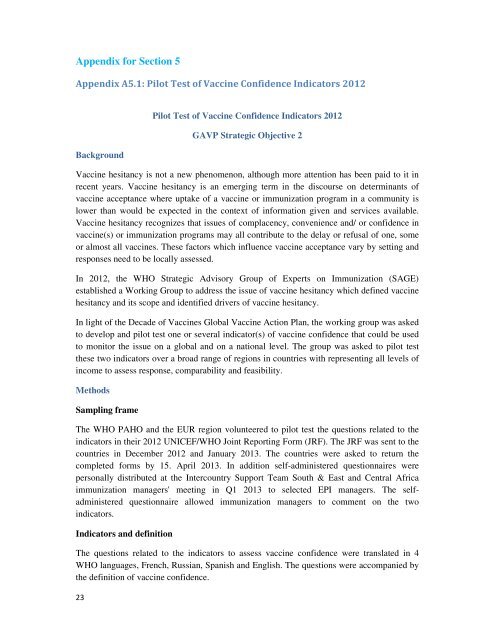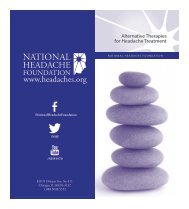2_SAGE_Appendicies_Background_final
2_SAGE_Appendicies_Background_final
2_SAGE_Appendicies_Background_final
Create successful ePaper yourself
Turn your PDF publications into a flip-book with our unique Google optimized e-Paper software.
Appendix for Section 5Appendix A5.1: Pilot Test of Vaccine Confidence Indicators 2012<strong>Background</strong>23Pilot Test of Vaccine Confidence Indicators 2012GAVP Strategic Objective 2Vaccine hesitancy is not a new phenomenon, although more attention has been paid to it inrecent years. Vaccine hesitancy is an emerging term in the discourse on determinants ofvaccine acceptance where uptake of a vaccine or immunization program in a community islower than would be expected in the context of information given and services available.Vaccine hesitancy recognizes that issues of complacency, convenience and/ or confidence invaccine(s) or immunization programs may all contribute to the delay or refusal of one, someor almost all vaccines. These factors which influence vaccine acceptance vary by setting andresponses need to be locally assessed.In 2012, the WHO Strategic Advisory Group of Experts on Immunization (<strong>SAGE</strong>)established a Working Group to address the issue of vaccine hesitancy which defined vaccinehesitancy and its scope and identified drivers of vaccine hesitancy.In light of the Decade of Vaccines Global Vaccine Action Plan, the working group was askedto develop and pilot test one or several indicator(s) of vaccine confidence that could be usedto monitor the issue on a global and on a national level. The group was asked to pilot testthese two indicators over a broad range of regions in countries with representing all levels ofincome to assess response, comparability and feasibility.MethodsSampling frameThe WHO PAHO and the EUR region volunteered to pilot test the questions related to theindicators in their 2012 UNICEF/WHO Joint Reporting Form (JRF). The JRF was sent to thecountries in December 2012 and January 2013. The countries were asked to return thecompleted forms by 15. April 2013. In addition self-administered questionnaires werepersonally distributed at the Intercountry Support Team South & East and Central Africaimmunization managers' meeting in Q1 2013 to selected EPI managers. The selfadministeredquestionnaire allowed immunization managers to comment on the twoindicators.Indicators and definitionThe questions related to the indicators to assess vaccine confidence were translated in 4WHO languages, French, Russian, Spanish and English. The questions were accompanied bythe definition of vaccine confidence.



